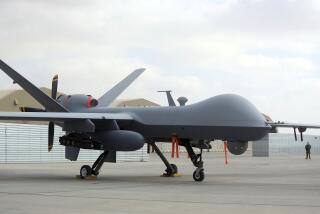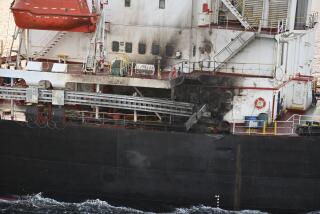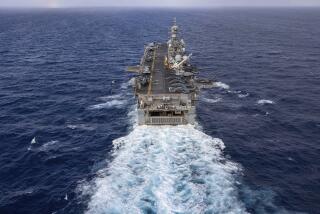NATO Ready to Use Cruise Missiles Against Bosnian Serbs
- Share via
WASHINGTON — Allied military commanders are prepared to use Tomahawk cruise missiles to knock out Serbian air defenses in northwest Bosnia if the rebels do not ease their siege of Sarajevo, U.S. officials said Friday.
The attacks, which could come within days despite an accord forged by the warring parties in Geneva on Friday, would be launched from U.S. Navy vessels stationed in the Adriatic Sea. The Navy has two surface ships in the area, each capable of launching 122 Tomahawks, as well as a missile-firing submarine.
Although no final decisions had been made, officials said Friday that North Atlantic Treaty Organization commanders are likely to use the Tomahawks because cruise missiles can be guided to their targets by satellite navigation systems and are not dependent on clear weather, as manned fighter-bombers are.
If the Tomahawks are used, it will mark the first time that the allies have deployed cruise missiles against Bosnian Serb targets and will constitute a major intensification of the current air campaign, at least in symbolic terms. The Geneva agreement envisions a peace plan for the Balkans but makes no mention of a cease-fire.
A senior U.S. official said Friday that one of the principal advantages of using the Tomahawks would be that they would “send the Serbs a message that we [the allies] are serious.” The missiles, which cost about $1 million each, are considered among the premier weapons in the U.S. arsenal.
Military commanders hope to attack huge complexes of Serbian weapons in northwest Bosnia-Herzegovina--with targets ranging from sophisticated air defenses to high-level command centers, ammunition dumps and major supply depots.
Part of the reason for turning to Tomahawks is that some allied air sorties over the past two weeks have been hampered by bad weather, forcing NATO commanders to postpone the air strikes or reduce the number of bombing missions flown on a particular day.
Use of the massive cruise missiles also would enable the allies to knock out rebel Serb air defenses in the area without risking the prospect that NATO warplanes would be shot down before the antiaircraft batteries were destroyed. Tomahawks are preset to locate a specific geographical point.
And military officials said that the highly accurate Tomahawks would help limit “collateral” damage to civilian structures and civilians themselves. “There are no downsides to this [use of Tomahawks],” one senior official said.
The Tomahawks were last used extensively in the spring of 1993, when U.S. warships fired nearly 50 of the missiles against the Iraqi central intelligence headquarters in Baghdad in retaliation for alleged Iraqi complicity in an assassination plot against former President George Bush.
The Iraqi complex was destroyed.
U.S. officials denied Friday that use of Tomahawks would mark any intensification of the war. A Pentagon strategist said that the decision to attack targets in northwest Bosnia would be merely an extension of the target list that authorities drew up several weeks ago.
The list, designed to cover several days’ worth of air attacks, initially focused on destroying rebel Serb air defenses around Sarajevo, but earlier this week NATO pilots began branching out to include other regions of the country, such as those around Tuzla and Mostar.
NATO warplanes have been seriously impeded by fog and clouds. Pilots complain that the fog prevents night missions and forces them to carry out their attacks in broad daylight, when they are most easily visible to antiaircraft crews. And they often must fly low because of clouds, making them vulnerable to shoulder-fired missiles and even to ordinary machine-gun fire.
Pilots of F-16 fighters and F/A-18 attack planes must be able to see their targets to aim their laser-guided weapons. The Tomahawk, however, requires no such sighting.
More to Read
Sign up for Essential California
The most important California stories and recommendations in your inbox every morning.
You may occasionally receive promotional content from the Los Angeles Times.













